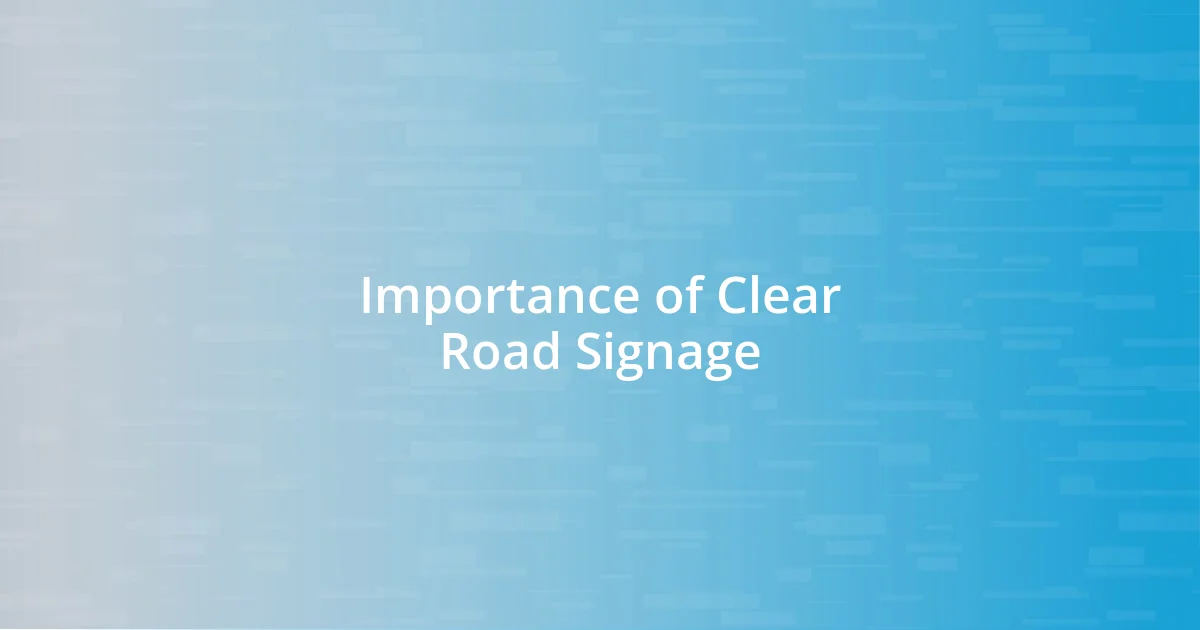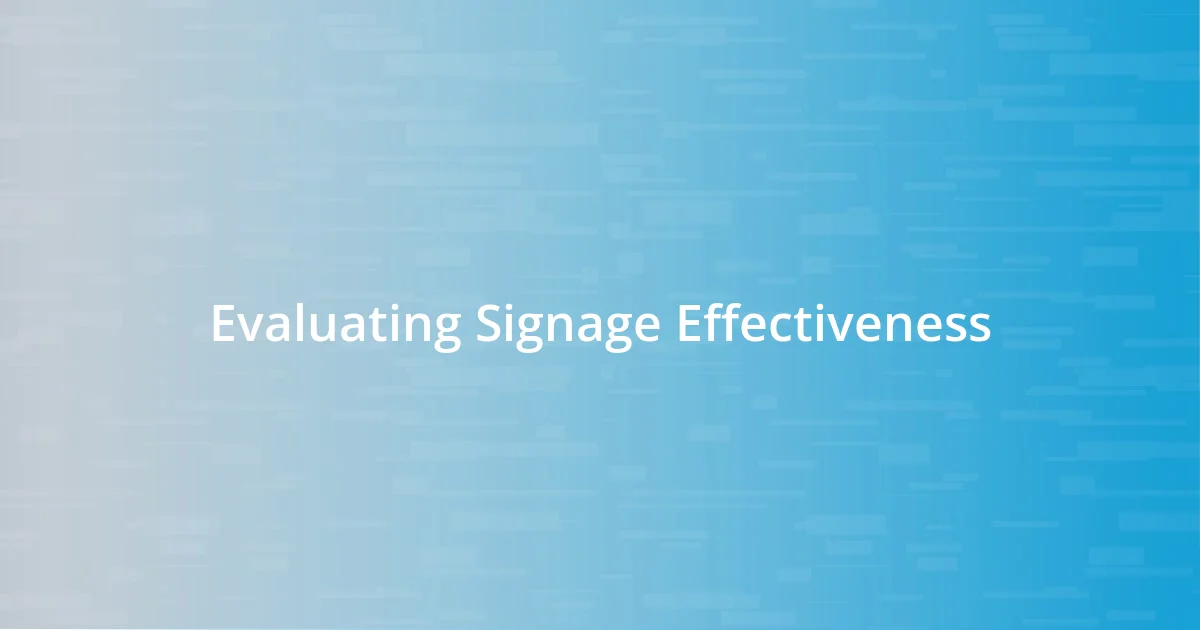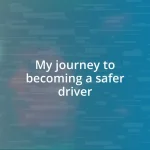Key takeaways:
- Clear road signage is crucial for driver safety, reducing anxiety and improving navigation through familiar and unfamiliar areas.
- Current issues include obscured or poorly designed signs, highlighting the need for standardization and community engagement in signage design.
- Innovative solutions like digital signs, 3D signage, and solar-powered options enhance visibility and communication, contributing to safer driving experiences.

Importance of Clear Road Signage
Clear road signage is not just about regulations; it’s about safety and guiding us through our journeys. I remember driving through a small town late at night, and an unclear sign caused my heart to race as I took a wrong turn. Can you imagine the anxiety of being lost in an unfamiliar place, simply because a sign was obscured or poorly designed?
When signage is clear, it empowers drivers to make timely decisions, ultimately reducing the risk of accidents. I think back to a trip I took where bright, well-placed signs led me seamlessly through a construction zone. It was a relief to know exactly what to expect, helping me feel in control rather than anxious. Isn’t it comforting to trust that the signs you rely on are easy to read and understand?
Furthermore, effective road signage enhances the overall driving experience. When I see signs with vibrant colors and straightforward instructions, it reassures me that others on the road are equally informed. How often have you found yourself feeling grateful for an easily recognizable sign that simplified a tricky intersection? Clear signage is a silent partner in our road journeys, quietly contributing to our safety and peace of mind.

Current Issues with Road Signage
It’s surprising how many current road signage issues can impact our day-to-day driving experiences. From my own journeys, I’ve encountered signs that are either too small to read or completely hidden by overgrown vegetation. I vividly recall a time when I missed a crucial turn because the directional sign was practically swallowed by tree branches — what a frustrating experience! It’s these little details that can turn a simple drive into a stressful scenario.
- Confusing symbols or messages
- Signs obscured by foliage or structures
- Deteriorated signs lacking visibility
- Inconsistent signage styles across regions
- Inadequate information about road conditions
Each of these problems speaks to a broader concern: the need for standardization and clarity in road signage. When navigating unfamiliar areas, the last thing I want is to second-guess a sign’s meaning. It’s all about that confidence in knowing what’s ahead, right?

Innovative Signage Solutions
Innovative approaches to road signage can significantly enhance both functionality and aesthetics. For instance, I’ve seen digital signs that adapt to real-time traffic conditions, providing timely updates. The first time I encountered one, I was amazed by how it guided drivers away from congested areas, making my journey much smoother. Isn’t it impressive how technology can contribute to safer driving experiences?
Another exciting solution comes from using 3D signage. I once drove in a town where the street signs seemed to leap out at me, thanks to clever designs. This not only made them easier to see but also added a touch of creativity to the driving environment. Imagine how engaging it could be to interact with vibrant, eye-catching signs that clearly communicate essential information!
Additionally, reflective materials can dramatically improve nighttime visibility. On a late-night road trip, I noticed how some signs glowed brightly against the dark backdrop, creating a sense of security. This innovation reminds drivers of their presence even in low light, allowing for a more confident driving experience. Why settle for something ordinary when we have such amazing options available today?
| Signage Solution | Description |
|---|---|
| Digital Signs | Real-time updates based on traffic conditions for safer navigation. |
| 3D Signage | Eye-catching designs that enhance visibility and aesthetic appeal. |
| Reflective Materials | Improves visibility at night, boosting driver confidence. |

Community Engagement in Signage Design
Community engagement in the design of road signage can significantly enhance the effectiveness and relevance of these important navigational tools. I remember attending a local meeting where residents shared their thoughts on the signs in our area. Hearing their diverse perspectives allowed me to see common misunderstandings that designers might overlook, like the need for clearer symbols that resonate with the community.
It’s fascinating to consider how incorporating community input can lead to more inclusive designs. I often think about how my own neighborhood has its specific quirks; for example, we have an annual festival that draws large crowds, yet the signage for parking and detours was lacking. By involving our community in the design process, we could create signage that not only meets practical needs but also celebrates our local identity.
Engaging the community in signage design also builds a sense of ownership and pride, making each sign feel like a collaborative effort. I believe this personal touch resonates with drivers; when I see signs that reflect local culture or history, it not only gives me vital information but also creates a comforting sense of belonging. Shouldn’t our roadways reflect the unique stories of the places we travel through?

Technology Enhancements in Signage
Enhancements in technology for road signage are truly a game-changer. I remember driving through a city plagued by unpredictable traffic, and suddenly, a dynamic digital sign caught my eye. It displayed not just the typical warnings but also real-time updates like accident alerts, which completely altered my route plan and saved me precious time. Isn’t it incredible how a simple technological upgrade can significantly impact our daily commutes?
Another fascinating aspect is the rise of augmented reality (AR) applications that interact with signage. I once stumbled upon a trial program where drivers could use their smartphones to scan signs for more detailed information, like history and local attractions. This thoughtful integration not only enhances navigation but also transforms road signs into engaging tools of discovery. How often do we get to learn something new on the road while simply following directions?
Moreover, consider the use of solar-powered LED signage, which is a more sustainable solution. On my weekend hikes, I’ve come across signs powered by solar energy, illuminating trails even in the darkest parts of the forest. This integration not only showcases technological benefits but also reflects a growing commitment to eco-friendliness. Wouldn’t it be great if we could bring that environmentally conscious approach to urban road signage as well?

Best Practices for Signage Installation
Installing signage correctly can make a world of difference in how effectively it communicates. I’ll never forget the time I drove through a new city and struggled to find my way because the signs were placed too high, making them nearly impossible to read from a distance. It’s essential to position signs at eye level, ensuring they catch the attention of drivers without causing distractions. Is there anything worse than missing a crucial turn because a sign was simply out of sight?
Moreover, consistency in design is critical for clear communication. During a recent road trip, I noticed how various states maintained different styles and colors for speed limit signs. This inconsistency created confusion for me and my fellow travelers. Establishing uniform standards for signage can help the public quickly recognize and understand essential information without hesitating. Have you ever felt puzzled by road signs that didn’t look familiar?
Finally, ongoing maintenance should never be neglected. I vividly recall a faded stop sign I encountered in my hometown; it was almost invisible during a rainy afternoon. Regular inspections and updates not only preserve clarity but also ensure that signage remains relevant to changing road conditions and community needs. Isn’t it reassuring to drive knowing that the signs are maintained, guiding you safely along your journey?

Evaluating Signage Effectiveness
Evaluating the effectiveness of road signage goes beyond simply measuring visibility; it involves understanding how well these signs communicate critical information to drivers. I remember the time I approached a busy intersection with new electronic signs that flashed warnings about pedestrian crossings. The impact was immediate. Drivers, including myself, reluctantly slowed down and approached with caution—proof that timely information can drastically alter driving behavior. How often do we overlook the real power of well-placed signage in preventing accidents?
Another key aspect of evaluating signage effectiveness is conducting driver feedback surveys. I’ve taken part in a local survey once where I had to rate different signs I often encountered. This not only made me more aware of their design and visibility but also opened my eyes to how others perceive them. It’s fascinating how a brief question can spark such discussions about the nuances of signs that many of us pass by without a second thought. Have you ever taken a moment to consider how your experience with road signs mirrors that of your fellow commuters?
Finally, performance metrics like accident rates can serve as an indirect measure of signage effectiveness. I once lived in a neighborhood where a new speed limit sign was installed, and I observed a noticeable shift in driver behavior. The previously high accident rates dropped significantly within months. This experience affirmed my belief that signs aren’t just passive structures; they actively shape the environment they inhabit. Isn’t it reassuring to realize that simple changes, like a visible sign, can create a safer community for everyone?
















